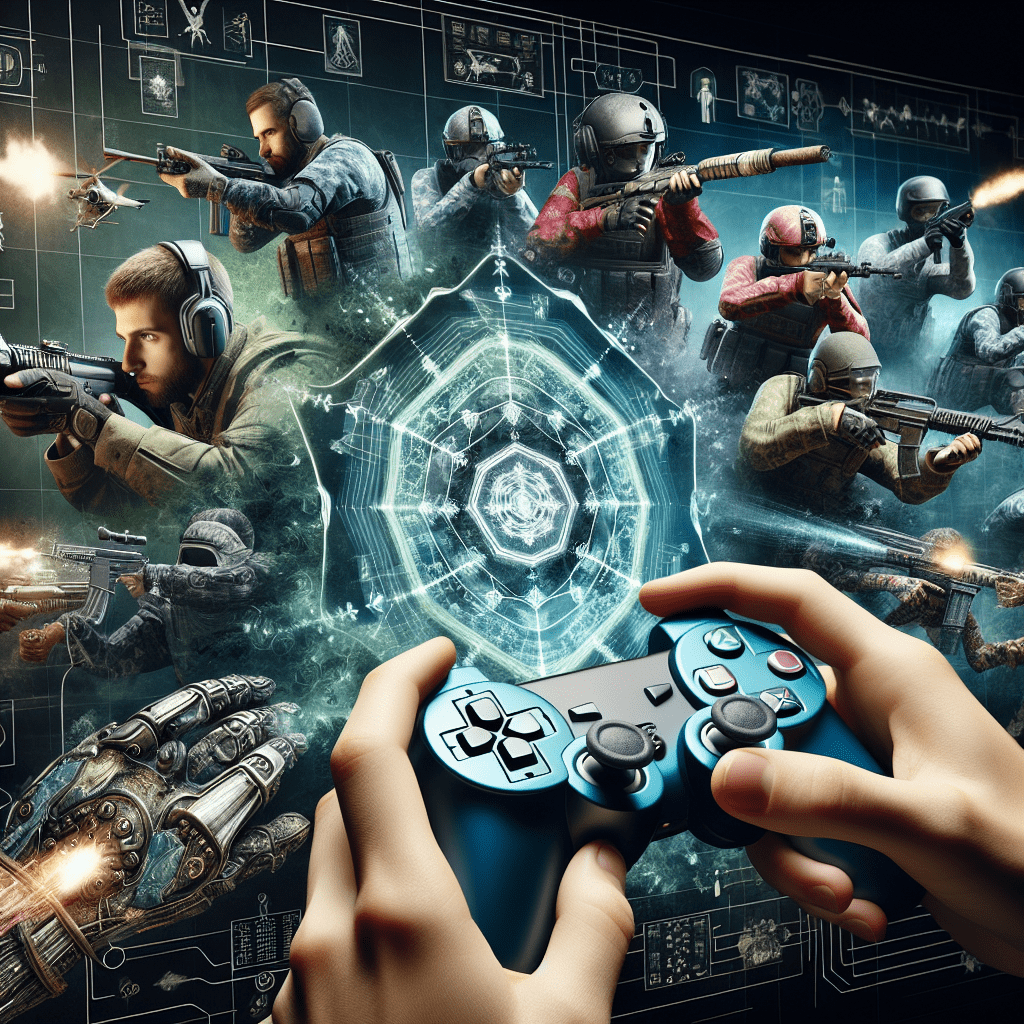Introduction
From the clunky arcade machines to the sleek consoles of today, gaming technology has come a long way. At its core, gaming technology encompasses the tools, software, and hardware that power our digital gaming experiences. It’s the wizardry behind the curtain that transforms ones and zeroes into sprawling fantasy worlds and adrenaline-pumping racetracks.
The journey of gaming technology is a tale of pixels and polygons, starting from the rudimentary 2D shapes of Pong to the hyper-realistic 3D models in today’s AAA titles. Innovation is the lifeblood of this industry, pushing the boundaries of what’s possible and continually redefining entertainment. In this exploration, we’ll delve into the latest innovations that are shaping the gaming industry and examine their impact on developers and gamers alike.
Advancements in Graphics Technology
Graphics are the first thing that catches a player’s eye, and they’ve been on an impressive journey. The evolution from 2D to 3D graphics was a game-changer, literally. It allowed for new genres, more complex gameplay, and immersive worlds that players could lose themselves in for hours on end.
Enter ray tracing, the latest buzzword in gaming graphics. It simulates the way light interacts with objects, creating lifelike shadows and reflections. This technology, combined with High Frame Rate (HFR) gaming, ensures that not only do games look stunning, but they also run smoother than a greased-up hedgehog on a hot tin roof.
| Graphics Milestone | Impact on Gaming |
|---|---|
| 2D to 3D Transition | Opened up new dimensions for gameplay and storytelling. |
| Ray Tracing | Enhanced realism with accurate lighting and shadows. |
| High Frame Rates | Smooth gameplay that’s easy on the eyes. |
The impact of these graphics advancements isn’t just about looking pretty; it’s about creating a sense of presence. When the digital sun sets just right over a virtual landscape, you can’t help but feel a part of that world. That’s the magic of immersion, and it’s only getting stronger with each graphical leap forward.
Virtual Reality (VR) and Augmented Reality (AR) Developments
VR and AR are the cool kids on the gaming block, offering experiences that range from diving into fantastical realms to chasing cartoon monsters in your backyard. The current state of VR and AR in gaming is like a sci-fi dream come true, with headsets getting more advanced and more affordable.
Breakthroughs in VR headset design are all about increasing comfort and decreasing the likelihood of you walking into a wall. Meanwhile, AR has found a cozy home in mobile and console gaming, blending the real world with digital overlays that spark joy and wonder.
| VR/AR Innovation | Contribution to Gaming |
|---|---|
| Improved Headset Design | Enhanced comfort for extended play sessions. |
| Mobile AR Games | Accessible AR experiences on devices we already own. |
| Console AR Integration | New gameplay mechanics using the living room as a canvas. |
The future prospects of VR and AR in gaming are as vast as the virtual universes they create. We’re talking about full-body tracking that lets you kick virtual butt with your actual legs, and AR games that turn cities into playgrounds. It’s an exciting time to be a gamer, with a front-row seat to the blending of realities.
Cloud Gaming and Game Streaming Services
Cloud gaming is like Netflix for video games; it streams games directly to your device, no bulky hardware required. This wizardry allows you to play the latest titles on almost any device that can connect to the internet, from smartphones to smart fridges (okay, maybe not fridges… yet).
Game streaming platforms are popping up like mushrooms after a rainstorm, each with its own library and perks. The advantages for users are clear: goodbye expensive hardware, hello playing AAA games while lying in bed with a tablet.
| Streaming Platform | Unique Selling Point |
|---|---|
| Platform A | Exclusive game titles and seamless integration with existing ecosystem. |
| Platform B | Monthly subscription model with a vast game library. |
| Platform C | High-quality streaming with low latency. |
But it’s not all sunshine and rainbows in the cloud. There are challenges like internet connectivity and latency that can turn your game into a slideshow if not addressed. Yet, the potential of cloud gaming is undeniable, offering a future where games are more accessible and more connected than ever before.
Artificial Intelligence (AI) in Gaming
AI in gaming is like having a super-smart friend who can also shape-shift. It’s behind the cunning enemies you face, the believable NPCs you interact with, and the personalized experiences that make each playthrough unique.
Adaptive AI is the next step, creating game worlds that react to your playstyle. Imagine enemies that learn from your tactics and evolve, or stories that twist and turn based on your decisions. It’s like the game is getting to know you, which is both thrilling and a tiny bit creepy.
| AI Feature | Benefit to Gaming |
|---|---|
| Dynamic Difficulty Adjustment | Keeps the game challenging but fair. |
| Procedural Content Generation | Endless new worlds and experiences. |
| Personalized Gaming | Custom-tailored experiences for each player. |
AI-driven personalization takes things a step further, tailoring games to your likes and dislikes. It’s like having a game that’s your personal DJ, always knowing the right tune to play. But with great power comes great responsibility, and the ethical considerations of AI in gaming are a hot topic. We’re looking at a future where games might know us better than we know ourselves.
Next-Generation Gaming Consoles
The latest gaming consoles are like sports cars: sleek, powerful, and packed with features that make you go “ooh.” They’re not just about raw power, though; they’re about creating ecosystems where games, streaming, and social features live in harmony.
Hardware and performance improvements mean faster load times, more detailed worlds, and smoother gameplay. It’s the difference between a flipbook and a high-speed car chase in terms of visual and performance fidelity.
| Console Feature | Impact on Gaming |
|---|---|
| SSD Storage | Near-instantaneous load times. |
| Backward Compatibility | Play your old favorites on new hardware. |
| Integrated Streaming | Share your gameplay with the world with ease. |
Integration with other gaming technologies is where consoles really flex their muscles. They’re becoming the central hub for all your gaming needs, whether that’s VR, cloud gaming, or cross-platform play. The future of console gaming is looking more connected and more versatile, breaking down barriers between platforms and players.
Wearable Gaming Technology
Wearable gaming technology is like strapping a science fiction gadget to your body. It’s all about enhancing the gaming experience with haptic feedback suits that let you feel the game, and gloves that track your every gesture.
Innovations in this space are turning gamers into pseudo-cyborgs, with devices that provide tactile sensations for every explosion or gentle rain in-game. It’s the kind of tech that blurs the line between the virtual and the real, making gaming a full-body experience.
| Wearable Device | Gaming Enhancement |
|---|---|
| Haptic Feedback Suits | Feel the impact of in-game actions. |
| Motion Tracking Gloves | Precise hand and finger tracking for VR. |
| Biometric Monitors | Games that react to your physical and emotional state. |
Biometrics are the secret sauce in wearable gaming tech, measuring everything from heart rate to sweat levels. This data can be used to adjust game difficulty or even change the narrative based on how you’re physically reacting to the game. The potential for wearable tech in gaming is huge, promising more realism and more personalized experiences.
The Rise of Esports and Competitive Gaming Tech
Esports is like the Olympics of gaming, only with more neon lights and less running. It’s a global phenomenon that’s turning gaming into a spectator sport, complete with fans, sponsors, and big-money tournaments.
The technological advancements in competitive gaming setups are all about giving players the edge. We’re talking high-refresh-rate monitors, ergonomic chairs, and peripherals that respond to the twitch of a finger.
| Esports Tech | Contribution to Competitive Gaming |
|---|---|
| High-Refresh Monitors | Buttery-smooth visuals for split-second reactions. |
| Ergonomic Gaming Chairs | Comfort for those marathon gaming sessions. |
| Performance Tracking Software | Detailed analytics to improve player skills. |
The role of analytics and performance tracking in esports can’t be overstated. It’s like having a coach that never sleeps, constantly analyzing your gameplay to find areas for improvement. The impact of these innovations on the accessibility and popularity of esports is clear, making it easier for anyone to get in the game and compete at the highest levels.
Conclusion
We’ve journeyed through the pixelated plains and the virtual valleys to see the key innovations that are reshaping gaming. These advancements are not just about cooler graphics or more immersive experiences; they’re about changing the way we play, create, and connect with each other.
The significance of these innovations stretches beyond the screen, influencing culture, society, and even how we perceive reality. As we continue to push the boundaries of what’s possible, gaming technology will not just reflect our imaginations but expand them, playing a pivotal role in shaping the future of entertainment.
FAQs
What is the impact of ray tracing on gaming graphics?
Ray tracing enhances the realism of gaming graphics by simulating accurate lighting, shadows, and reflections, leading to more immersive and lifelike environments.
How is AI changing the gaming experience?
AI is revolutionizing gaming by creating dynamic and responsive game worlds, personalizing experiences, and introducing adaptive difficulty, making each playthrough unique and engaging.
What are the benefits of cloud gaming?
Cloud gaming offers the ability to play games on various devices without the need for powerful hardware, reducing costs and making gaming more accessible.
How do wearable gaming devices enhance gameplay?
Wearable gaming devices like haptic feedback suits and motion tracking gloves provide tactile sensations and precise controls, increasing immersion and realism in games.
What role does technology play in the growth of esports?
Technology plays a crucial role in esports by improving competitive gaming setups, providing analytics for performance tracking, and enhancing the overall experience for players and viewers.







